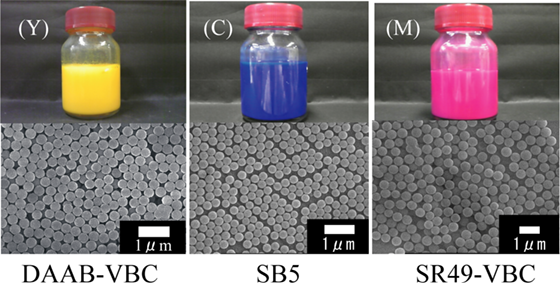All issues

Predecessor
Volume 85, Issue 12
Displaying 1-5 of 5 articles from this issue
- |<
- <
- 1
- >
- >|
The Special Issue / Colour Materials For The IT Age
Original Research Paper
-
Masanori TAMURA, Mana AMANO, Tsubasa SHIME, Toshiki HORIGUCHI, Shinich ...2012 Volume 85 Issue 12 Pages 483-488
Published: December 20, 2012
Released on J-STAGE: March 20, 2013
JOURNAL FREE ACCESSFerroelectric liquid crystals (FLCs) have unique characteristics, such as high-speed response, wide viewing angle, and bistability. Their high-speed response allows the realization of the field sequential color system for next generation liquid crystal displays (LCDs). On the other hand, the bistability is disadvantageous for LCDs which possess grayscale or full-color capability. In this study, we focus on the polymer-stabilized V-mode ferroelectric liquid crystals (PSV-FLCs) photocured in the SmA phase. We research in detail how the fabricating conditions of PSV-FLCs such as polymer concentration, cell gap, photocuring energy and materials influence the monostable capability. As a result of experiment, it is obvious that the higher the concentration of polymer is and/or the thicker the cell gap is, the lower the bistable memory angle is. Furthermore, it is found that the memory angle depends on the photocuring energy and takes a minimum value at a certain energy. Moreover, It is found that the memory angle may also depend on the kinds of the polymer materials. A short alkyl spacer and/or a large molecular weight of the monomer can more strongly stabilize FLC alignment due to the formation of more rigid polymer networks. Fig. 2 Fullsize ImageField sequential color system.View full abstractDownload PDF (1959K)
Fig. 2 Fullsize ImageField sequential color system.View full abstractDownload PDF (1959K)
Review
-
Hideo KONNO2012 Volume 85 Issue 12 Pages 489-494
Published: December 20, 2012
Released on J-STAGE: March 20, 2013
JOURNAL FREE ACCESSOrganic light-emitting diodes (OLEDs) have attracted a great deal of attention due to their potential use in lighting apparatus as well as future panel displays applications because OLEDs have a high contrast ratio, a short response time, and a wide viewing angle. Phosphorescent materials such as cyclometalated Ir (III) complexes have been regarded as one of the most important key materials in the field of OLEDs. Here we show recent research development of phosphorescent materials, especially focusing on blue phosphorescent cyclometalated Ir (III) complexes.View full abstractDownload PDF (839K)
Digest
-
Yoshiumi KOHNO2012 Volume 85 Issue 12 Pages 495-498
Published: December 20, 2012
Released on J-STAGE: March 20, 2013
JOURNAL FREE ACCESSFlavylium dye has the same skeleton as that of the naturally occurring anthocyanin dye. In addition, flavylium is known to exhibit photochromism between the corresponding 2-hydroxychalcone. Therefore, flavylium is a candidate for an environmentally friendly functional material. The original photochromic properties of flavylium and the investigation of wide usage of the dye are presented.View full abstractDownload PDF (760K)
Current Topics
-
Norihisa KOBAYASHI2012 Volume 85 Issue 12 Pages 499-504
Published: December 20, 2012
Released on J-STAGE: March 20, 2013
JOURNAL FREE ACCESSThe demand for global environmental conservation and decrease of CO2 evolution as well as for a portable display with light-weight and low-power consumption require the development of “new imaging media”, instead of paper. This display is categorized as reflective display and is called “electronic paper”. Many technologies are proposed to fabricate reflective display, but microcapsulated electrophoretic system is the leading technology at present. Electrochromic system in which the color change is induced by electrochemical reaction is also a potential candidate to realize color reflective this play. In this paper, the material as the color material for electrochromism and its application for display are reviewed. Further, new electronic paper system are also commented upon.View full abstractDownload PDF (1332K) -
Chikara TAKEDA, Ryu KOHASE, Ayano HIRAI, Kazushi ENOMOTO, Atsushi NARU ...2012 Volume 85 Issue 12 Pages 505-512
Published: December 20, 2012
Released on J-STAGE: March 20, 2013
JOURNAL FREE ACCESSElectronic rewritable papers have recently attracted a great deal of interest for use in information displays, requiring low cost, low weight, good flexibility, and low power consumption. The fabrication of the displays can be achieved in several ways, such as by using cholesteric liquid crystals, twisting white-black balls, mobile fine particles with liquid crystals, in-plane electrophoretic particles, or micro-encapsulated electrophoretic particles. Among these different materials, microencapsulated electrophoretic displays (EPDs) offer an advantage of lower manufacturing cost, since they can be fabricated by a roll-to roll method. In this article, we report the preparation and particle size control of novel high performance white and color microspheres by dispersion polymerization in low dielectric constant media, such as Isopar and silicone oils. We also report new preparation methods of stable dispersions of TiO2 fine particles encapsulated with polymers and the chargeability control of the particles in the hydrocarbon media. Fig. 14 Fullsize ImageView full abstractDownload PDF (2466K)
Fig. 14 Fullsize ImageView full abstractDownload PDF (2466K)
- |<
- <
- 1
- >
- >|